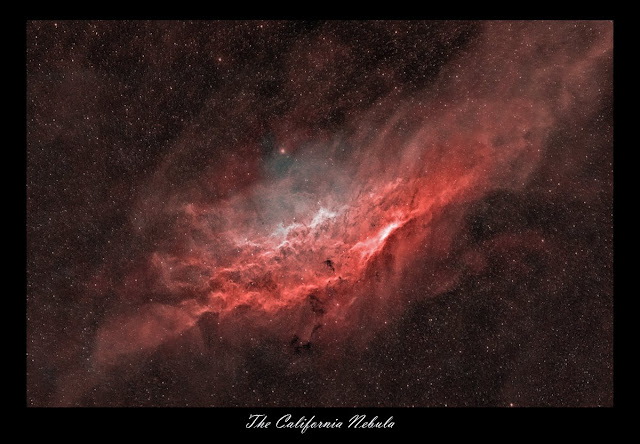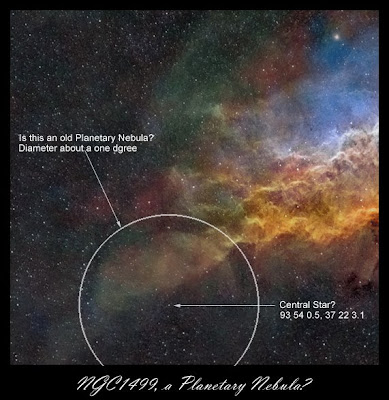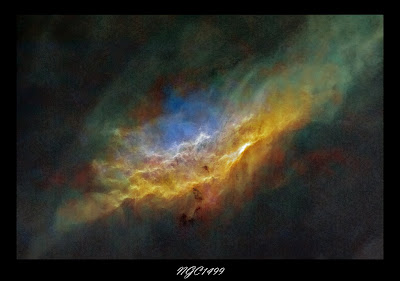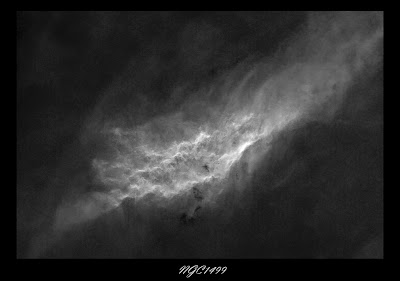COPYRIGHT, PLEASE NOTE
All the material on this website is copyrighted to J-P Metsavainio, if not otherwise stated. Any content on this website may not be reproduced without the author’s permission.
Have a visit in my portfolio
PORTFOLIO:https://astroanarchy.zenfolio.com/
Friday, March 6, 2009
The California Nebula, NGC1499
-
-
At night of 25.02.2009 I shot more lights for NGC1499, the California Nebula,
to see how deep I'm able to go.
-
Original narrowband color image can be seen here:
-
I borrowed O-III and S-II cahnnels from there and added them to new H-a channel to
boost it with, otherwise missing, wavelenghts.
After that I used this O-III and S-II boosted H-a image as a new luminance over the the
original.
-
Original data can be found behind the link, new data is:
13x600s8, Binned down 2x2 + 4x1200s, Binned 1x1 with Canon EF 200mm @f1.8.


I haven't been able to find any information about this formation.
It looks to me like an old Planetary Nebula?
If you have any information about this, please, leave a message.
-
-
I add here a small animation about processing steps of the O-III channel.
Information in this channel is very dim and a special threadment is needed to reveal it.
In attached GIF-animation normally stretched O-III image is not showing any obivious shades.
When stars are removed image can be stretched very differently, since I don't have to
care about bloating stars.
(In narrowband imaging Stars, as they are broadband targets and contanes no relevant information, can be removed.)
In a final stage of processing all stras are returned, with a special tecnique, with no data lost.
The animation is a gropped from midle of the O-III image.
-

Klick to image to see an animation, note. large size, 3.2MB.
-

NGC1499 in HST-palette without Stars to better show the actual nebulosity.
href="https://blogger.googleusercontent.com/img/b/R29vZ2xl/AVvXsEjBMaCfAB55BjeLhyphenhyphenUbxhbfu84oyDmE43MvnEAk7Bp6C_xRZRNyoQXMNU6miWsptxYHYe_E_O99tioUWadI9naFkyJH8ZDteFDEnkpOyB8uB0yoYT5LP3usMuRt5v7JiwMDjo8GQGE00VI/s1600-h/NGC1499_H-alpha_NoStarsMEDIUM.jpg">

NGC1499 H-alpha light without Stars.
Wednesday, March 4, 2009
Monday, March 2, 2009
Sh2-240 as Stereo Pair
Ones more I have redone this Supernova remnant Stereo precentation. I wasn't happy with it before, now it looks some how better, I think.
-
Here is the original APOD image from Jan. 17 2009:
and here the APOD page:
Labels:
stereo images
6. Universe Today article
This time Tammy Plotner used a Comet Lulin image taken and Volumized by me.
-
You can read the article from here:
Labels:
publications,
stereo images
Virgo Cluster of Galaxies

At the same nigh, than previous Sharpless target, I shot this beautiful Galaxy Cluster in Virgo. I needed a data for calibrating my QHY9 and Canon 200mm EF f1.8 optics orthogonality. I didn't wait much about image, since 200mm lens has litle bit too wide for galaxys. After all, it turned to be a nice image, so I post it here too.
Labels:
Canon 200mm f1.8 images,
galaxy images
Sunday, March 1, 2009
Virgo Cluster as a Stereo Pair
 For Parallel Vision
For Parallel Vision
 For Cross Vision
-
Viewing Instructions, please, look for the Right hand side menu.
For Cross Vision
-
Viewing Instructions, please, look for the Right hand side menu. -
Labels:
stereo images
Two ways to end a life in HST-palette

In this rare image two Stars has ended they lifes. Right one is an old, very dim and large, Planetary Nebula and the Left one is an extremely dim Supernova remnant.
The North is Up and the field of view is about 5,5 degrees horizontaly.
I have seen very few images of eather of them, and never seen it as a three colour narrow band.
Objects in the image are from the Sharples Catalog.
Upper one is Sh2-216 and the lower one Sh2-221.
There is other smaler Sh2-objects there, Sh2-217 and Sh2-219,
they are located in Auriga.

Natural color composition, mixed from H-a, O-III and S-II channels.



Since I haven't seen this ever in NB colors, I added an image about content of the channels.
A special technique is used to dig out a very faint information.
-
IMAGING DATA:
Camera, QHY9
Optics, Canon EF 200mm f1.8 @ f1.8
Guiding, QHY5 + PHD-guiding
Platform, Meade LX200 GPS 12"
Exposures:
H-a = 9x1200s
S-II = 14x300s binned 3x3
O-III = 11x300s binned 3x3

If someone elese has observed this older, double ionized Sulfur, outburst,
please inform me.
Thursday, February 26, 2009
Cone and Rosette Nebula mosaic!

Cone and Rosette in HST-palette. Image spans horizontally 10 degrees.


Same image with reduced stars to show the nebulosity better.
 Area in "natural" colors. Mixed from narrowband data; Red=70%H-a + 30%S-II, Green=100%=-III and Blue=85%O-III+15%H-a - -
Area in "natural" colors. Mixed from narrowband data; Red=70%H-a + 30%S-II, Green=100%=-III and Blue=85%O-III+15%H-a - -

 Area in "natural" colors. Mixed from narrowband data; Red=70%H-a + 30%S-II, Green=100%=-III and Blue=85%O-III+15%H-a - -
Area in "natural" colors. Mixed from narrowband data; Red=70%H-a + 30%S-II, Green=100%=-III and Blue=85%O-III+15%H-a - -
At night of 24.02. I shot this data before a Comet Lulin in previous post. I allway wanted to show this interesting area between Rosette and Cone. As can be seen in the image, they both are part of same large nebula complex.

A horizontal versions Are for your viewing pleasure. Here is a real postion in the Sky, North up.  This area is sometimes called as a "Christmas Tree Cluster". Now I can see why! With current equipments I can have both, highresolution and wide field. - - IMAGING DATA: Camera QHY9 Guiding QHY5 Optics Canon EF 200mm f1.8 lens Platform LX200 GPS 12" - Exposures for Cone Nebula part: H-a = 2 x 1200s S-II = 2 x 600s O-II = 2 x 600s - Exposures for Rosette Nebula part: H-a = 3 x 1200s S-II = 2 x 600s O-III = 2 x 600s - Final image is 7000 x 2500 pixels and the resolution is 5,5 pixels/arc second
This area is sometimes called as a "Christmas Tree Cluster". Now I can see why! With current equipments I can have both, highresolution and wide field. - - IMAGING DATA: Camera QHY9 Guiding QHY5 Optics Canon EF 200mm f1.8 lens Platform LX200 GPS 12" - Exposures for Cone Nebula part: H-a = 2 x 1200s S-II = 2 x 600s O-II = 2 x 600s - Exposures for Rosette Nebula part: H-a = 3 x 1200s S-II = 2 x 600s O-III = 2 x 600s - Final image is 7000 x 2500 pixels and the resolution is 5,5 pixels/arc second
 This area is sometimes called as a "Christmas Tree Cluster". Now I can see why! With current equipments I can have both, highresolution and wide field. - - IMAGING DATA: Camera QHY9 Guiding QHY5 Optics Canon EF 200mm f1.8 lens Platform LX200 GPS 12" - Exposures for Cone Nebula part: H-a = 2 x 1200s S-II = 2 x 600s O-II = 2 x 600s - Exposures for Rosette Nebula part: H-a = 3 x 1200s S-II = 2 x 600s O-III = 2 x 600s - Final image is 7000 x 2500 pixels and the resolution is 5,5 pixels/arc second
This area is sometimes called as a "Christmas Tree Cluster". Now I can see why! With current equipments I can have both, highresolution and wide field. - - IMAGING DATA: Camera QHY9 Guiding QHY5 Optics Canon EF 200mm f1.8 lens Platform LX200 GPS 12" - Exposures for Cone Nebula part: H-a = 2 x 1200s S-II = 2 x 600s O-II = 2 x 600s - Exposures for Rosette Nebula part: H-a = 3 x 1200s S-II = 2 x 600s O-III = 2 x 600s - Final image is 7000 x 2500 pixels and the resolution is 5,5 pixels/arc second Wednesday, February 25, 2009
Comet Lulin
-
It seems, that there is lots of ionized gas in the comet Lulin.
I was litle sceptical about using narrowband filters to a broadband target, like a comet.
After all, there was plenty of signal from all three bands, S-II, H-a and O-III, there is even large differenses between differnt bands (look for the last image of this post)
Colors are mixed isn HST (Hubble Space Telescope) palette.
With extermely fast f1.8 200mm lens I used exposures from UHC-s filter's 30s
to 600s for Hydrogen alpha filter.
-
The field of view is about five degrees!
The tail in the image is about 2.2 degrees
 A starless version
A starless version
 This is a fast comet, exposure time about an hour.
-
Eguipments:
Canon EF 200mm @ f1.8
camera, QHY9
Guiding, QHY5 and PHD-guiding
Exposures, H-a, S-II, O-III and UHC, total five hours.
This is a fast comet, exposure time about an hour.
-
Eguipments:
Canon EF 200mm @ f1.8
camera, QHY9
Guiding, QHY5 and PHD-guiding
Exposures, H-a, S-II, O-III and UHC, total five hours.
Labels:
Canon 200mm f1.8 images,
Comets
Saturn & Comet Lulin as a Stereo Pair
Saturn is a bright planet in the upper part of the image. There is two moons visible next to saturn, Lapetus (upper one) and the Hyperion. Other moons can not be seen, since they are under the extence glow from the Saturn.
-
Labels:
stereo images
Comet Lulin animation
-
-
Animation of Comet Lulin shows its movement in an one hour.
25 x 100s exposures with UHC-s filter.
Colors are imaged with H-a, S-II and O-III filters and HST-palette is used.
Labels:
Comets
Saturday, February 21, 2009
5. Universe Today article
 A new article by Tammy Plotner in Universe Today:
A new article by Tammy Plotner in Universe Today:
I turned this Hubble Heritage image of the "Ring Nebula" to the Spatial format.


Cross Vision version
-
Distances and shapes in 3D-image are visualizations, since we don't have enough information to buil an accurate model. However, the 3D-model of the target is not only a lucky guess as there is many known "anchor points" in the image, witch can be used to estimate the actual forms and the relative distances.
Parallel Vision version
Labels:
publications,
stereo images
Thursday, February 19, 2009
Cone Nebula area, NGC2264
This H-alpha narrowband image from last night, shows a large area around
the "Cone Nebula". Lots of nebulosity around there.

-
Cone Nebula, H-alpha
Note the "Hubble's Variable Nebula" at Five a clock position.
(A small cometlike dot in the image)

A Starless version to show the nebulosity better.

 A grop from the center. This lens is very sharp, even full open @f1.8
A grop from the center. This lens is very sharp, even full open @f1.8

 A grop from the center. This lens is very sharp, even full open @f1.8
A grop from the center. This lens is very sharp, even full open @f1.8
-
-
Weather in this winter has been #&%@$£2 and last night was no exception.
After four hours I managed to save four 20 min. exposures,
others were ruined by the speeding clouds.
-
IMAGING DETAILS:
Optics, Canon FD 200mm f1.8 @ 1.8
Camera, QHY9 astro camera
Guiding, QHY5 and PHD-Guiding on LX200 GPS 12"
Exposures, 4x1200s +darks, bias and flats
Filter, Baader 7nm H-alpha
Monday, February 16, 2009
IC443 in HST-palette

Last night was clear for a long time, I used it to shot
IC443 Supernove remnant. This was a first light for my new Observatory,
POD (Personal observatory Dome).
-
The O-III signal is weak. After some extreme stretching of the data
there was plenty of it after all. I have not noticed before how far it continues
outside of the Hydrogen alpha area. O-III can be now seen at seven a
clock from the main formation and some faint areas in upper left corner with H-alpha.
-
Exposures:
-H-alpha 8x1200s binned 1x1
-S-II 4x600s binned 2x2
-O-III 5x600s binned 2x2
Optics:
Tokina 300mm TX f2.8 @ f2.8
Camera:
QHY9 @ -50 C
Guiding:
Lx200 GPS 12" + LQHY5 and PHD-Guiding

Note an extended Triple Ionized Oxygen outburst in lover left from main feature in middle.
IC443 as a Stereo Pair
 Parallel vision version
Parallel vision version  Cross vision version - -
Cross vision version - -
IC443 with some volume.
The result is more or less an educational guess about real 3D appearance of this formation. - Two versions, first for Parallel Vision , and the second for Cross Vision method. - The original image and the image information can be found here: http://astroanarchy.blogspot.com/2009/02/ic443-in-hst-palette.html
Labels:
stereo images
Sunday, February 15, 2009
4. Universe Today article

A new article by Tammy Plotner in Universe Today: http://www.universetoday.com/2009/02/14/v-is-for-valentine-v838/
At this time I turned the Hubble Space Telescopes image of V838, in Monocerotis, to the spatial format. -


Cross Vision version
-
Distances and shapes in 3D-image are visualizations, since we don't have enough information to buil an accurate model. However, the 3D-model of the target is not only a lucky guess as there is many known "anchor points" in the image, witch can be used to estimate the actual forms and the relative distances.
Parallel Vision version
Parallel Vision version
Labels:
publications,
stereo images
Subscribe to:
Posts (Atom)




























